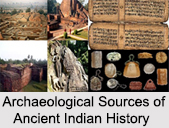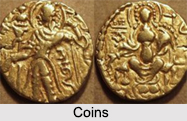 Archaeological Sources of Ancient Indian History refer to the sources which are obtained by the process of archaeological excavations. Fundamentals of ancient Indian history have indeed been available to Indians for thousands of years, however arrangement of all these in a chronological order is important. Archaeological Sources of Ancient Indian History therefore have played a major part in delineating history whilst telling the tales of the ancient Indians and constructing or reconstructing the history of a region.
Archaeological Sources of Ancient Indian History refer to the sources which are obtained by the process of archaeological excavations. Fundamentals of ancient Indian history have indeed been available to Indians for thousands of years, however arrangement of all these in a chronological order is important. Archaeological Sources of Ancient Indian History therefore have played a major part in delineating history whilst telling the tales of the ancient Indians and constructing or reconstructing the history of a region.
Archaeological Sources of Ancient Indian History for identifying the ancient Indian history consist of coins, inscriptions, monuments and sculptures and other artefacts. Some of the Archaeological Sources of Ancient Indian History are as follows:
Monuments
Methodical and systematic assessment of ancient monuments and buildings and other works of art generate archaeological evidence. General Sir Alexander Cunningham and Sir William Jones from Asiatic Society of Bengal, hold the credits for excavating the pre-Aryan era. The Indus Valley Civilisation and the Harappa and Mohenjodaro were discovered by Daya Ram Shahni in 1921. It was India`s oldest habitat which dates back to 400,000 and 200,000 BC, known as the second Inter-Glacial period. The excavation and scientific analysis of palaces, stupas, temples and residential houses and other religious and social buildings provide an estimation of the situation that existed in ancient epoch.
Inscription
One of the most trustworthy evidence can be attained from numerous inscriptions. These are writings principally engraved on stone pillars, copper, bronze plates, iron, gold, silver, rocks temple walls and bricks and are generally uncorrupted. Majority of the stone inscriptions, venerate certain events or record various dedications. Such documents include detailed Sanskrit poems and accounts of pilgrims. Inscriptions in Sanskrit, Telugu, Tamil, Prakrit, Pali and also Kharosti and Brahmi scripts have been discovered. The inscriptions discovered from the era of emperor Ashoka provide the most factual data of his period. Inscriptions of by Harisena, the court poet of Samudragupta, of Allahabad Prasasti, and Kharvela, emperor of Kalinga give significant facts for the restoration of Indian history.
 Coins
Coins
Numismatics or the analysis of ancient coins requires specialised skills and knowledge. Numerous ancient coins of Indian origin have been unearthed which gives an estimation of economic condition and currency structure of that time. Various types of coins from Samudragupta`s era give a detailed account of current conditions. Even the dates inscribed on the coins testify the chronology of events in ancient India. Various information and data have been obtained about the Indo-Greek, Indo-Parthian era from the coins prevalent in those times.
Paintings and Sculptures
Rock paintings of the period have survived in the caves of Buddhist and Jain monks. These were usually depictions of facts observed from their day to day lives; however there were many scenes from the life of the Buddha and tales from the Jataka and other such books. Sculptures show the state of artistic technique and it shows gradual refinement through the years.
Proper observations and inferences drawn from the study of various Archaeological Sources of Ancient Indian History provide a proper assessment and overview of ancient India. The Archaeological Sources give some knowledge of the life of the ancient people. India is rich with ancient ruins, remains and monuments.






































